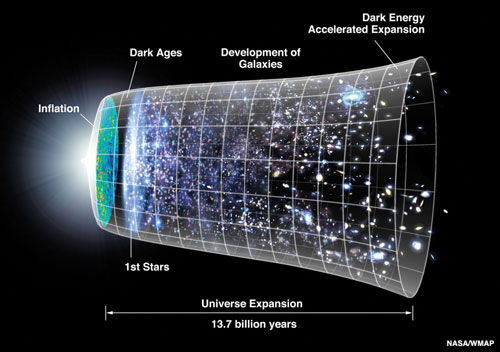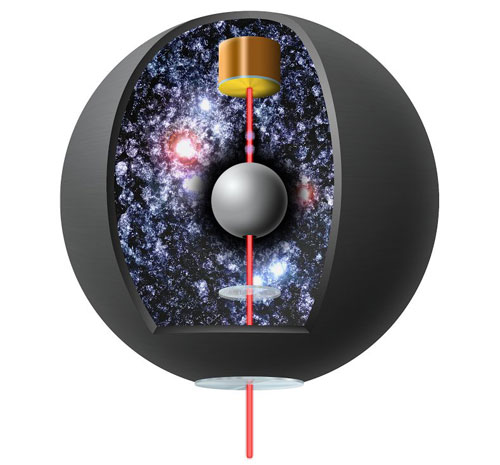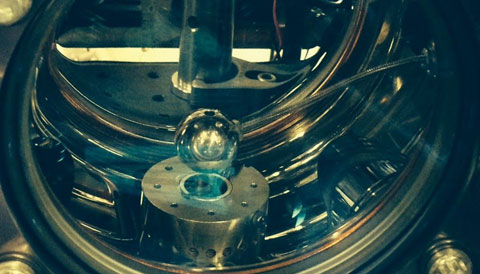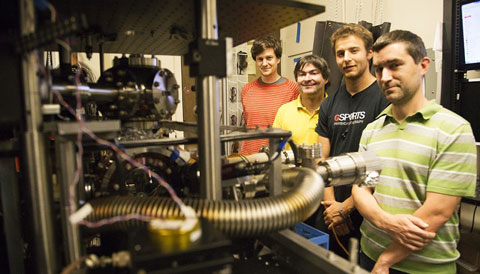A lab experiment has all but nixed one of the theories of dark energy, a mysterious force pushing the universe apart.

NASA / WMAP
One of the most bizarre discoveries of the 21st century was that the universe is expanding at an accelerating speed. The culprit behind this ramp-up, called dark energy for lack of a better term, is an unknown force that’s pushing the universe’s expansion so that as cosmic time goes on, galaxies fly faster and faster apart. Yet despite its implications for the fate of our universe, astronomers have no idea what dark energy is.
Now a new (and really awesome) experiment, reported in the August 21st Science, has narrowed down the field of possibilities.
Scientists have come up with a couple of ideas for the nature of dark energy. One camp supposes it’s the energy pent up in empty space itself, known as the cosmological constant. True to its name, it should stay constant from the Big Bang onward. But the theory has some problems — most notably it overpredicts the energy density of the cosmic vacuum by 120 orders of magnitude (yikes!).
Another camp instead suggests quintessence, a fifth fundamental force that doesn’t have to be constant — it could have arisen at some point in the early universe and might one day gradually fade away again. But so far scientists have failed to detect this fifth force in the lab. So in 2004 Justin Khoury and Amanda Weltman (both then at Columbia University) suggested a modified scenario: chameleons.
In the world of physics, particles and forces are two sides of the same coin, with particles acting as “force carriers.” Chameleon particles carry the chameleon force, and just like their namesakes, these particles adjust to their surroundings to hide from detection. But rather than change color, they change mass.
Amidst the high-density environs of Earth, the theory goes, chameleons take on high mass, and high-mass subatomic particles are difficult to detect. In consequence, the fifth force that they carry would become weak and all but impossible to measure. But in emptier space, chameleons shed mass. The fundamental force they represent would thus be felt over longer ranges, and could act over cosmic scales to affect the universe’s evolution.
To Catch a Chameleon

Simca Bouma
Khoury and Weltman’s ingenious theory remained out of practical reach for about a decade — it was simply too difficult to test. Then in early 2014, Clare Burrage (University of Nottingham, UK) and colleagues developed an idea for an experiment that could do the trick.
The key, they said, is to use a vacuum. In a vacuum, scientists could test the chameleon force without the obscuring effects of matter. (To read the details, take a look at the excellent article, “The Chameleon in the Vacuum Chamber.”)
When Paul Hamilton (University of California, Berkeley) read Burrage and colleagues’ article, he realized that he could do the test with an experiment he had already helped develop.
Hamilton and Holger Müller (also at Berkeley) had built a small spherical vacuum chamber just 10 centimeters across with a solid aluminum sphere at the center. Into this sphere, the physicists dropped in a few (read: 10 million) cesium atoms and flashed a laser beam at them, three flashes separated by 10 milliseconds.
The first laser beam splits the cesium atoms into two packets of information. (Remember, this is quantum mechanics world, where particles can behave like waves: “splitting an atom” in this case has a probabilistic meaning that has nothing to do with actual nuclear fission.)

Holger Mueller
Since the first beam sent the two packets recoiling away from each other, a second flash reverses their direction and sends them back together. Then a third laser beam acts as a beam splitter, causing the two cesium waves to overlap and interfere with each other, like two sets of ripples in a pond. The whole laser light show takes just 1.7 seconds.
The cesium atoms’ interference pattern will show the effect of gravity combined with the chameleon field — but the experiment found only gravity at work. With this null result, Hamilton and Müller’s team was able to rule out the existence of chameleon particles over a wide range of masses.
And in fact, the results might end up being even better than what’s reported in Science. Burrage’s theoretical work came out in early 2014, but this past July Sandrine Schlögel (University of Lamur and Louvain University, Belgium) and colleagues released a new-and-improved version of those difficult calculations. This development, says Hartmut Abele (Technical University of Vienna, Austria), may already have increased the experiment’s range, narrowing the possible masses for chameleon particles even further — by up to a factor of 10.
“The experiment by Paul Hamilton and colleagues is a huge step forward in chasing the chameleon field,” Abele concludes. “Future experiments with atoms or neutrons will either find a chameleon signal or exclude chameleon fields completely.”
Khoury agrees, stating in a press release, “[Müller] is now pushing his experiment into areas where chameleons interact on the same scale as gravity, where they are more likely to exist.”
What the Future Holds for Dark Energy

Enar de Dios Rodriguez
What’s significant to physicists involved in this research is that the experiment was small, done in a university lab, yet probed complex physics that had previously been out of reach. “I think it’s very reassuring,” adds Jörg Schmiedmayer (also at the Technical University of Vienna), “that the most fundamental science can sometimes be probed in clever, small-scale experiments and doesn’t always need mega collaborations and mega facilities.”
What’s even more reassuring about this result is that it promises that a definitive, yes/no answer is on the horizon. There are no free parameters to tweak, no theoretical modifications that could evade a null result — future experiments will reveal for certain whether chameleon particles exist.
But what’s less reassuring is that if they’re ruled out, then we’re back to square one: the cosmological constant or quintessence scenarios, along with all their attendant problems.
 8
8









Comments
John-Umana
August 25, 2015 at 11:12 am
Interesting article. Dark energy is the repulsive force behind the continuing expansion of the universe. Is it energy in empty space? No. Is it "quintessence" (whatever that is supposed to mean) that does not have to be constant? What is true is this - dark energy does not have to be constant. The rate of acceration of the universe can conceivably change (speed up or slow down). What is wrong with both hypotheses is a great deal - dark energy is not a force that operates FROM WITHIN the cosmos at all. Rather, dark energy is a force that is external to the physical universe, but which acts upon it. There are no chameleon particles. Keep at it, guys, but don't be afraid to think outside the box. Does the phrase "outside of the physical universe" have empirical sense? Yes.
You must be logged in to post a comment.
Peter Wilson
August 27, 2015 at 1:30 pm
Consider four bodies, each of mass M, at the corners of a square, with sides of length R. Double the distance between all, so the sides are now 2R. How much energy does this take? About 3.41 GM^2/R joules. Now do the calculation with two bodies, each of mass 2M, a distance sqrt(2)R apart, so that the total mass and density is same. Double the distance, as before. How much energy does this take? About 2.83 GM^2/R j.
While the mass, density and expansion are the same in both cases, the latter takes less energy. It represents a “clumpier” state, like the aging universe. As stars form and galaxies collide, the same expansion requires less energy. Think riding a bicycle, approaching the top of a hill: as the grade flattens, you go faster. The universe is growing clumpier; expansion requires less energy; the grade is "flattening." Ergo, acceleration may be expected.
Currently the standard model does not include this “clumpiness” effect. It should. As the above calculation shows, R does matter; density alone does not define the system.
You must be logged in to post a comment.
Jlummel
August 29, 2015 at 1:43 pm
@Peter Wilson - so then that energy differential between the clumpyness and non-clumpyness states would be the theoretical Dark Energy?
Imagine if you could harness that...
Actually I think the wrong question is being asked, accelerated as compared to what? We can only really see our little part of the universe, so it's like defining the entire world from the perspective of having only lived in Brooklyn.
I was born and raised in Arizona where it's VERY dry. The first time I saw the Mississippi River the person I was with was explaining how people hitch hike up and down the river all year long. It took me several years to reconcile and understand what I heard since it made no sense to me at the time, I mean, what did the hitchhikers do in the summer when the river dried up?
Eventually I realized I was making assumptions based on a limited worldview. I think that's where this science is at as well.
You must be logged in to post a comment.
ROBERT STENTON
August 28, 2015 at 4:59 pm
The anti-gravity effect of Dark Energy is indeed strange. But it is true for all four forces of nature that at lower energy levels, time slows down. In the case of gravity, your feet age slower than your head. In the case of the electromagnetic force, an electron in a lower orbital travels slower through time than its higher energy, high orbital brothers. Protons and neutrons in lower orbitals also travel slower through time. It is also true that as objects approach the speed of light, they too travel slower through time (The Twin Paradox). So maybe the principle that unites all 4 forces of nature and the Dark Energy force is simply that time wants to slow down. That would be consistent with the idea that as time slows down less happens and less happening is the definition of stability. So a Universe that is expanding at an ever increasing speed may simply be trying to travel through time more slowly and is, therefore, moving towards a more stable energy state. If no particles or forces can be found to otherwise explain Dark Energy, then we might just have to attribute the strange behavior of Dark Energy to an effect of Relativity which was initially called by Einstein a Theory of Gravity.
You must be logged in to post a comment.
Lindsay
August 28, 2015 at 11:56 pm
Peter Wilson. It seems to this poor chemist that you have given us a simple and brilliant proposal. If I understand what you said, we do not need 'dark energy' to explain the accelerated expansion of our Universe. Hopefully, the physics experts will work on your idea to see if it fits all the data. But we still need dark matter (right?) to explain the way galaxies rotate (conservation of angular momentum, etc.)
You must be logged in to post a comment.
ROBERT STENTON
August 31, 2015 at 10:53 am
Dear Lindsay,
Thank you for your comment. Yes, Dark Matter is needed but if we consider "matter" to be made of protons and neutrons and electron, Dark Matter may not be "matter" at all. This would explain why it is not detectable. Since there is more Dark Matter than matter in the universe and matter is made of 3 quarks, then we would have to assume that if Dark Matter was made in the Big Bang, it was easier for Dark Matter to be make in the Big Bang than was "matter". So I believe that if Dark Matter is made of only one type of particle must be made up of only one or two quarks. If made of one quark, it would have to be a yet undiscovered stable quark; if two quarks, it would be a force carrier and since heavy particles decay into lighter particle, it would have to be the lightest of the force carriers. Finally it could be a menagerie of many types of undiscovered particles. Particle physicists would not be surprised if super families of particles exist, in fact, many are expecting this and particles with more than 3 quarks have now been detected.
You must be logged in to post a comment.
Peter Wilson
August 31, 2015 at 12:50 pm
Thanks, Lindsey.
We may still need DE, but the clumping has to be included, if only to rule it out. My fear is that some math-whiz in the physics dept will understand me, as you have, insert R into the Ricci curvature tensor equations, solve the matrix calculus--way over my head--publish the results…and I‘ll read about it here!
You must be logged in to post a comment.
August 29, 2015 at 4:39 pm
Interesting article. I do not know all the models that are being examined to explain the phenomenon we have observed in the supernova studies of a universe whose expansion is speeding up most recently. However, I would hope that one of the models would examine the possibilities that this is not a result of pressures changing within the universe, but outside the observable universe...i.e. as more of the universe disappears over the observable horizon, more of that part of the universe is sucking on the rest of it. Think of a roller coaster, as it slowly moves over the apex of the tracks, and more of it is then hauling on the universe in a changing pulling fashion, rather than a compressing manner. This thought has lingered with me since the Supernovae Survey findings came out.
Jim Carlisle
You must be logged in to post a comment.
You must be logged in to post a comment.